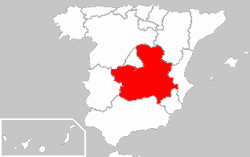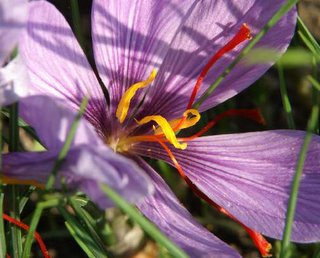
“This dish combines all of the ingredients most often associated with Spanish cooking – garlic, saffron, sherry, and almonds – into an unusually savoury sauce” Penelope Casas[i]
Last night we went for a very typical Spanish casserole dish. It is a dish that was frequently served at the Spanish court in the 17th century…
That is at least how this blog could have started. As it turns out, I misunderstood where we were going. Instead of going for a CAzuela, we went to see a ZARzuela. This is basically a Spanish musical; alternating scenes of speaking and singing. It rose to fame in the Spanish courts during the 17th century. We went to see “Agua, azucarillos y aguardiente”, written in 1897 by the composer Federico Chueca.

Anyone who has been to the West End of London will know that musicals are not the hardest to grasp. From what I can understand, zarzuelas consist of Spaniards going to the theatre to see how Spaniards live. We arrived a little late when the cast was dancing and singing, the next scene focused on relationship problems, the next on financial problems, the next on tapas, the next on landlord problems, work problems… As with many things in Spain, the Virgin Mary had a somewhat unorthodox role during the production, she seemed to be there to guard the raffle prizes that were located to the left of the stage during the show. As it turns out my parents-in-law won the prize (ham and wine), so thank you Mary.

"La Mancha" means "the stain"... harsh on the citizens, but that's Spanish politics for you...
I don’t want this to be a “nearly not a casserole blog” so I’m going to loosely define a recent recipe as casserole … pollo en pepitoria. This is a recipe typical to Castillia-La Mancha. One of the 17 autonomous communities of Spain, Castillia-La Mancha is the central community of Spain (excluding Madrid). It is the flat land wherein much of Don Quijote (de la Mancha) is based. It is the 3rd largest community, with 79,463 km square and 9th in terms of population, with 1.8 m people.
Ingredients (for 4):
1 chicken
Flour
3 medium onions
3 garlic cloves
½ l of stock
½ cup of sherry or dry white wine
1 laurel leaf
100 g finely ground almonds
2 hard-boiled eggs
Saffron, salt and pepper
1 chicken
Flour
3 medium onions
3 garlic cloves
½ l of stock
½ cup of sherry or dry white wine
1 laurel leaf
100 g finely ground almonds
2 hard-boiled eggs
Saffron, salt and pepper

For the mise en place, finely slice the onions. I used a mandolin that we got in Japan. Crush the garlic with the fine end of a butcher knife.

Cut the chicken into portion sized pieces, season and roll in flour. In a large casserole heat the oil and sauté the chicken over a high heat until well brown. In order to maintain the heat of the pan, add only a few pieces at a time.
Sieve the oil so that a good tablespoon of oil remains. Reduce the heat and sauté the onion and garlic until translucent. It is best to leave the lid on the pot at this point as it will build up the heat and effectively steam the onion rather than flame cook it. Stir in the stock, sherry, saffron and laurel leaf. In order to get the strongest flavour from the saffron, it is worthwhile to toast it in tinfoil over a flame.
THE LAID BACK ENDING: There is an option in the recipe now. We followed the low-maintenance route which basically left the casserole to simmer for 1 ½ to 2 hours, until the chicken is bland. 15 minutes before the end we added the finely ground almonds and the chopped eggs.
THE FOOD ACADEMIC ENDING: Penelope Casas recommends a slightly more comprehensive method; simmer for 10 minutes. Remove the chicken and bay leaf to a warm dish. Blend the casserole with the ground almonds. Return all the ingredients to the casserole. Cover and cook at 350 F for 20 minutes adding broth as required. Sprinkle the egg only 5 minutes from the end.
A bit about Saffron[ii]:

Image courtesy of Gernot Katzer’s spice page.
Imparting both an intense yellow colour and unusual flavour to food, saffron is a vital part of many Spanish dishes. It was brought to Spain by the Arabs. The name is actually derived from the Arabic for “thread”. Iran and Spain are the major exporters of the spice today.
It is the world’s most expensive spice. There are 3 stigmata per saffron flower. It takes about 80,000 flowers to produce 5 lb of stigma, which in turn dry down to about 1 lb (450 g) of saffron… this relates to a 1,000 metre square field or, because the stigma are so delicate, 12 days for an experienced picker. All of the stigma must be harvested on the same day that the flower begins to open (typically a busy day in late autumn).
Crocin is the name for the intense colorant in saffron. It is a carotenoid pigment made up of a sandwich of one pigment between two sugar molecules. The sugar is the reason that the usually oil-soluble pigment is actually soluble in water and hence particularly useful in cooking. Alcohol is commonly used in conjunction in order to dissolve additional fat-soluble carotenoids.
The flavour is described varyingly as “notable bitterness”, “penetrating”, “hay-like aroma”, “unique flowery”, “medicinal” or… “subtle”.
Vocab builder:
Trocear – divide
Salpimentar – babelfish defines this as “to salpimentar”; “to season” is somewhat closer
Estofar – sauté
Endnotes and acknowledgements:
[i] Penelope Casas “Food and wine of Spain”
[ii] Harold McGee “McGee on Food & Cooking: an encyclopaedia of kitchen science, history and culture”


3 comments:
Dude,
We are going to do some cooking over Christmas and I will finally make an appearance in this weblog. Have you ever tried fishfingers a la king (burgerking)?
Posted by Mick
Mickie boooooy!
I assumed that you stopped reading somewhere back in the Japan days...
Looking forward to Christmas... fishfingers are always a treat; you're now dining in Burgerking? What a step up this is, didn't you used to cook cook them in the toaster?
later, coops
Posted by steve
If you think a collection of articles on Saffron might be of interest or use to you, and want to find out more, feel free to visit www.SaffronGuide.com .
btw, I don't sell anything, the site is just a collection of articles that I've collated, all used with permission. (You can click on the Articles1, 2, 3 & 4 links on the top right for a list of more.)
Posted by SaffronTips
Post a Comment